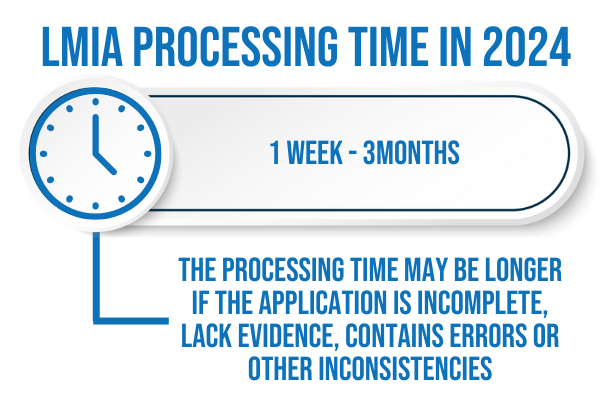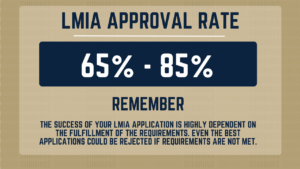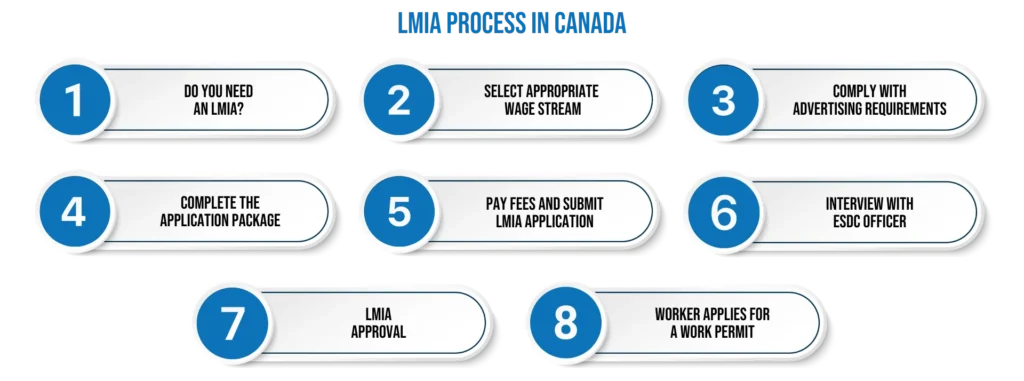Updated: July 2, 2025
If you’re a Canadian employer considering hiring someone from another country, you might be required to apply for LMIA (Labour Market Impact Assessment) from Employment and Social Development Canada (ESDC) first. This article is here to help you understand everything about LMIA. We’ll explain how the process works, what you need to do, the paperwork involved, how much it costs, when to expect things to happen, and what rules you must follow. Plus, we’ll give you some tips to make your LMIA application successful and answer some common questions that Canadian employers often have.
What is LMIA in Canada?
An LMIA is a document from Employment and Social Development Canada (ESDC) that a Canadian employer may need to obtain before hiring a foreign worker. Service Canada is the branch of ESDC responsible for processing LMIA applications. ESDC will assess how hiring a foreign worker might impact the job market in Canada. If it determines the effect on the Canadian market is positive or neutral, ESDC will grant your company a positive decision (LMIA) to hire a foreign worker. LMIA serves as a means for the government to ensure that bringing in a foreign worker does not negatively impact Canadian workers.
Not all employers are required to apply for LMIA. Check if you can hire your foreign worker without LMIA through one of the International Mobility Programs.
Learn all about Canada’s Tech Immigration programs.
How to Get LMIA Work Permit: Step-by-Step
To get an LMIA work permit for your foreign worker, follow the application process below:
The LMIA application process is a key component of the Temporary Foreign Worker Program (TFWP). The LMIA plays a critical role in addressing labor shortages in Canada, especially in key sectors like technology and agriculture.
-
Step 1: Identify the relevant NOC for the occupation
-
Step 2: Determine the wage rate for the occupation
-
Step 3: Draft a job posting according to the program requirements
-
Step 4: Advertise the position for at least 30 days
-
Step 5: Interview local applicants
-
Step 6: Collect documents and submit the LMIA application
-
Step 7: Pay the LMIA fees
-
Step 8: Attend an interview with an ESDC officer and
-
Step 9: Support your foreign worker’s work permit application
Employers are required to recruit by advertising job vacancies to locals first before they can hire foreign workers.
LMIA Processing Times in 2024
Generally, processing times can range from a few weeks to several months. ESDC updates processing times regularly to reflect current conditions. Processing times vary based on the type of LMIA and other external factors, such as regional demand and application volume. As of December 2024, LMIA processing times have increased across all streams in Canada. Submitting complete business legitimacy documents can help expedite the LMIA processing time. Average processing times for February 2024:
-
Global Talent Stream: 1-2 weeks
-
Agricultural stream: 1-3 weeks
-
Seasonal Agricultural Worker Program: 1-2 weeks (noted to be 7 business days in the latest update)
-
Permanent resident stream: 3-4 months
-
High-wage stream: 2-3 months
-
Low-wage stream: 2-3 months

The Costs of Your LMIA Application
When considering the hiring of a foreign worker through an LMIA application, you should budget between $5,500 and $8,000 per worker, as several costs are involved. Additionally, low-wage positions may take up to 53 business days for LMIA processing.
-
Advertisement Costs: If you are advertising on multiple paid platforms (which is recommended), your expected budget should be around $500-$600.
-
LMIA Application Fee: The government fee for an LMIA application is $1,000 per employee.
-
Work Permit Fees: If you are covering your worker’s work permit application fees, be prepared to pay an additional $480-$550 to cover your worker’s application fees, biometric collection fees, and medical examination costs.
-
Legal Fees: Depending on the complexity of the case and the required legal assistance, fees can range from $3,000 to $7,000 per worker.
For high-wage positions, employers must also submit a Transition Plan, which can add to the overall cost.
Note that this estimate does not include additional costs, such as the worker’s return airplane ticket to Canada, which may be necessary depending on the job offer and the wages provided.
It is crucial for employers to understand that they are legally obligated to bear all costs related to the LMIA application. Canadian law strictly prohibits employers from passing these costs on to foreign workers, whether directly or indirectly. This prohibition includes charges for recruitment, job orientation, First Aid training, and any other related fees. Additionally, ensure that the recruiters and third-party individuals assisting in the hiring process of foreign workers do not charge any fees to foreign workers under any pretext. Violating this regulation can lead to severe consequences, including the reimbursement of fees to the worker, a ban from the foreign worker program, hefty penalties, and even criminal prosecution.
Approval Rate for LMIA in 2024
Based on our experience, established companies enjoy an average success rate of 95% for their LMIA applications. In contrast, companies that have been operational for less than 12 months typically see success rates ranging between 65% and 85%. Several factors can impact the success of your LMIA application, with improper or insufficient advertising being a frequent reason for refusal. Thorough recruitment efforts are crucial for a successful LMIA application. Additionally, an employer’s inability to meet the wage or other employment terms often leads to application denial. Seeking advice from an experienced corporate immigration lawyer on your LMIA application can significantly improve your chances of approval.
Find out more about the Intra-Company Transfer program.

How to Identify the Correct NOC for Your LMIA Application
The NOC, known as the National Occupational Classification, is Canada’s way of organizing the different jobs that Canadians do in the job market. It gets updated every five years in collaboration with Statistics Canada to provide a standardized understanding of the labour market. The latest version of the NOC was released in 2021. Employers interested in hiring foreign talent should begin by choosing the appropriate NOC occupation. The NOC classification plays a crucial role in determining the prevailing wage and influencing ESDC’s assessment of local job opportunities, which ultimately impacts the outcome of your LMIA application. Furthermore, IRCC will use the NOC classification to understand employment requirements for your position and decide whether to approve your request for a temporary foreign worker. To identify the correct NOC for your position, follow the steps below:
-
Search the NOC: Visit NOC 2021 and search your occupation by title.
-
Review multiple NOC options: Based on our experience, in most instances, you’ll find several NOC occupation classifications to consider for each position. Given the extensive range of job titles in the 2021 NOC, along with considerable overlap among them, selecting the right NOC entails carefully assessing the lead statements in the NOC, the listed job duties, and the employment requirements. Do not just rely on the official job title when determining the most suitable NOC. It’s crucial to align your job duties and the employment requirements with the duties and the job requirements listed in one or more relevant NOCs.
-
Assess the local market conditions: Among other things, your NOC choice should consider the overall labour market situation for each NOC occupation classification in the particular geographic region. You should research the labour market situation for each potential NOC occupation (Job Bank Labour Market Information is a good starting point) and hopefully arrive at an NOC occupation classification that is an accurate reflection of the proposed job offer and where there also is a recognized shortage of local talent.
-
Confirm the minimum wage for the position: In addition to assessing the local labour market conditions, you must also ensure that the prevailing wage for your chosen NOC occupation classification is within your budget (see Determining the Prevailing Wage Rate below). Many employers set wages for foreign employees based on what others in their company earn or what the applicant agrees to. However, to get a positive LMIA, you must offer the prevailing wage rate to the foreign worker. This sometimes might mean paying your foreign talent more than your existing employees.
-
Ensure that your candidate meets the requirements for the NOC: Lastly, you must ensure that the proposed candidate satisfies the employment requirements for the proposed NOC occupation classification. While ESDC will generally not evaluate whether the foreign worker satisfies the employment requirements, the CBSA or Visa Officer who ultimately issues a Work Permit will no doubt perform this evaluation. There is nothing more frustrating than having your foreign worker’s application to work in Canada refused after you’ve gone through the hassle of securing a positive LMIA.
What Wage to Offer Your Foreign Worker
As an employer applying for an LMIA, you must ensure that the foreign worker receives at least the prevailing wage for the job and location where the worker will work OR a wage you pay your current employees in the same job and location if it’s higher than the prevailing wage. To check the prevailing wage for your position, follow the steps below:
-
Identify the relevant NOC occupation classification (discussed above).
-
Visit the Job Bank website, and in the Explore the Market section, select “by wages”. From there, type in the 4-digit NOC classification.
-
You may then select the relevant options based on your geographic location. If no recorded wage for the relevant occupation or geographic region exists, refer to the Provincial and then National median wage.
-
The median wage is the wage that must be met. However, note that some ESDC officers have verbally indicated that where a position is very senior, they may expect a higher wage salary to be offered.
If you are reluctant to offer the median wage to your foreign worker, your LMIA will fail. If you offer alternative forms of compensation, such as commissions, for example, the base salary must meet the prevailing median wage rate. Also, note that employers must review prevailing wages periodically and ensure that their foreign workers are paid the prevailing wage at the start of and throughout their employment period.
How to Draft a Job Posting for Your LMIA Application
Drafting an effective job posting for your LMIA application is crucial for your LMIA application success. Many Canadian employers make the mistake of drafting job postings based solely on their hiring needs, but it’s important to follow ESDC’s specific requirements. Failure to comply with the program requirements could result in your application being rejected for “insufficient recruitment efforts.” In summary, drafting an effective job posting for LMIA purposes requires strategic thinking and aligning your company’s hiring needs with ESDC’s instructions, as well as IRCC’s requirements.
Your LMIA job posting must include the following information:
-
Company name and business address
-
Job title
-
Job duties (if advertising for multiple vacancies, specify duties for each). Do not just copy/paste duties from the NOC occupation classification.
-
Employment terms (e.g., permanent, project-based)
-
Language requirements
-
Wage details (including any raises, performance pay, or bonuses):
-
A wage range can be provided, but the minimum wage must meet prevailing standards
-
Benefits offered (if applicable)
-
Work location(s) (local area, city, or town)
-
Number of positions
-
Contact details of the employer: email address, fax number, or mailing address
-
Skill requirements (including education and work experience)
A detailed job offer letter should accompany the job posting to ensure clarity and compliance with LMIA requirements.
How to Advertise Your Position for LMIA Application
When advertising for an LMIA, begin by registering your employer account on Job Bank, as all job advertisements must be posted on the Job Bank (or its provincial/territorial equivalents) for at least four weeks and must remain active until the LMIA is granted. Registering an employer account on Job Bank can take around 2 weeks, and it may take an additional 3-5 business days, for your job posting to become active. Do not advertise on other sources without having your Job Bank advertisement active and live.
Once your job advertisement is active on Job Bank, you can then post your job ad on other sources. Although you are required to post on 2 additional sources besides the Job Bank, having your job advertised on 3-4 additional platforms can act as a safety net. If one source is deemed unacceptable, you can rely on the others to support your LMIA application. In our practice, we usually advertise on at least 5 different platforms, including Job Bank. It’s crucial to target underrepresented groups in your advertising efforts to meet the new, stricter requirements set by Service Canada and ESDC. This includes advertising on sources that target groups such as Indigenous persons, vulnerable youth, newcomers, and persons with disabilities. The selection of advertising platforms should be strategic, ensuring they are consistent with the occupation and target an audience with the appropriate education, professional experience, or skill level required.
As an employer, you have the option to utilize various recruitment strategies, such as:
-
Print media, including national or provincial/territorial newspapers, magazines with national reach, specialized journals, and newsletters from professional associations.
-
General employment websites (examples include Indeed.ca, canadastop100.com, vault.com, eluta.ca, glassdoor.ca, LinkedIn, workopolis.com, monster.ca, etc.).
-
Occupation-specific websites tailored to particular fields like accounting, marketing, biotechnology, education, engineering, and more.
However, make sure to diversify your recruitment efforts and avoid using advertising channels that target the same demographic. For instance, do not use Workopolis.com and Monster.ca simultaneously or Craigslist and Kijiji to prevent overlap in audience targeting.
In our practice, a job advertisement for an LMIA may look like this:
-
Job Bank – mandatory (Cost: Free)
-
Source 1: Canada-wide source: Indeed.ca, Monster Jobs, Glassdoor or Eluta.ca (Cost: $200-$600 for 4 weeks)
-
Source 2: Occupation-specific platform: company’s website, specialized platforms or print media
-
Source 3: Backup Job Posting: Allstarjobs.ca (Cost: $40 for 90 days)
-
Source 4: Vulnerable Group 1: Newcomers and new immigrants: newimmigrantjobs.ca (approx. $50)
-
Source 5: Vulnerable Group 2: Aboriginal groups ($117 per job posting)
Some additional tips:
-
Maintain consistent proof of advertisement: Ensure that all your ads, including those on Job Bank, run simultaneously for 4 weeks. Collect evidence of your job postings weekly. You must submit documentation with your LMIA application showing that the job was advertised for at least four consecutive weeks with no gaps. This is crucial, as even a single day’s gap can jeopardize the LMIA application.
-
Be proactive with Job Bank: If a post is nearing its end date, renew it promptly to prevent any advertising gaps. This will help maintain continuous proof should ESDC review your recruitment efforts.
-
Be proactive with documentation: Don’t wait until the end of the advertising period to gather proof. Some websites may refresh posts, making it appear as though the advertisement wasn’t up for the full four weeks. Weekly, timestamped screenshots are invaluable for providing the necessary evidence.
By following these tips, you can demonstrate to ESDC that you have made a bona fide effort to fill your job vacancy domestically before seeking to hire foreign workers through the LMIA process.
How to Demonstrate Talent Shortage for Your LMIA Application
Once you complete the advertising campaign for your position across multiple platforms, meticulously review the applications received. Begin by recording the total number of local candidates who applied. Then, narrow your list to the top 10 candidates and initiate a telephone screening to gauge their interest and suitability for the role. Be sure to document the date and time of each screening call. Following this, invite the top three candidates for a formal interview. Should these candidates not fulfill the job requirements, consider interviewing an additional two to three candidates from your shortlist.
It’s a common misconception among employers that offering a job to a local candidate precludes proceeding with an LMIA application. This “all or nothing” belief is unfounded. You can continue with your LMIA application even after hiring a local candidate for the position. A positive LMIA decision can serve as a contingency for up to 12 months, providing flexibility should issues arise with your new hire or additional vacancies emerge. In practice, hiring locally can actually bolster your LMIA application and improve your chances of approval.
Finally, it’s crucial to document your recruitment efforts comprehensively. If you’re unsure how to proceed, you can check with LIA, our Legal Immigration Assistant chatbot, or book a consultation with our team for tailored guidance.
How to Submit Your LMIA Application
To apply for an LMIA, employers must collect and submit various documents to ESDC, which can now be completed online using the ESDC portal for employers. The specific documents required vary depending on the LMIA stream (e.g., high-wage, low-wage, agricultural, caregiver, etc.), but generally, the required documents include the following: Every LMIA application includes application forms, supporting documents, and payment of an LMIA processing fee unless exempted. An LMIA application will always occur under specific streams depending on the nature of the job.
-
LMIA Application Form: A completed and signed application form for the specific LMIA stream you are applying for.
-
Business Legitimacy Documents: Documents that prove the legitimacy and legal status of your business, such as a business license, incorporation documents, and tax documents.
-
Job Offer Letter: A detailed job offer letter to the foreign worker outlining job duties, wages, conditions of employment, and other relevant details.
-
Recruitment Efforts Documentation: Evidence of job advertisements across various platforms (e.g., Job Bank, other job boards, print media).
-
Transition Plan: For high-wage positions, a plan detailing how the employer intends to reduce reliance on temporary foreign workers in the future.
-
Processing Fee: $1,000 per worker, required for most types of LMIAs.
-
Union Consultation (if applicable): If the job is in a unionized position, proof of consultation with the union.
Additional Documents for Specific Streams: Depending on the LMIA stream, additional documents may be required. For example, agricultural and low-wage LMIA streams have specific requirements regarding housing arrangements and transportation plans for workers.
How to Prepare for Your Interview with the ESDC Officer for Your LMIA Application
An LMIA interview with an ESDC officer is a critical step in the process of hiring a foreign worker. You should approach this interview with thorough preparation and a clear understanding of your business needs, as well as the specifics of the job position you are looking to fill. Here are some helpful tips for employers to get ready for their LMIA interview:
-
Who should attend the interview with ESDC? Appoint a person from your company who has a deep understanding of your business and its operations. This individual should be prepared to discuss the specifics of the job role, the necessity for a foreign worker, and the efforts made to recruit domestically. Additionally, having your legal representative present during the interview can be highly beneficial. They can provide clarity and support in answering any legal questions posed by ESDC officers, ensuring that your responses are accurate and comply with relevant laws and regulations.
-
Have your documents ready: documentation and detailed records are your best allies. Ensure you have all relevant information at your fingertips, including your legal and operating names, Business Number (BN), and contact details. Be prepared to discuss your recruitment efforts in detail: where you advertised the position, the number of applicants, the interview process, and specifically why Canadian applicants were not suitable or could not be trained for the position. This includes providing a breakdown of the qualifications, experience, and skills you are seeking and how the applicants did not meet these criteria.
-
Practice interview questions: Lastly, practice interview questions in advance with your legal representative. You must be able to clearly explain how hiring a foreign worker will benefit your business, such as filling a labour shortage, leading to job creation or retention of Canadian employees, or facilitating the transfer of skills or knowledge. You can practice your answers by downloading our complimentary guide featuring Practice Interview Questions with ESDC Officers.
Remember, the goal of the LMIA interview is to ensure that hiring a foreign worker will not adversely affect the Canadian labour market. Demonstrating a genuine need for a foreign worker, backed by thorough documentation and a clear understanding of your business and the job role, will help make your case compelling to the ESDC officer.

How to Support Your Foreign Worker’s Application to Work in Canada
Supporting your foreign worker’s application to work in Canada is a critical step in ensuring their successful entry and integration into the Canadian workforce. The IRCC is the final authority responsible for processing work permit applications, the final step that follows the LMIA approval. It’s important to recognize that IRCC may reject an application if they are not convinced of the worker’s ability to perform the job. After investing time and resources in obtaining an LMIA, it would be highly disappointing to see the work permit application fail. To mitigate this risk, provide your worker with a comprehensive job offer that clearly outlines the duties, terms, conditions, and wages of the position.
In addition to a detailed job offer, providing your worker with a letter of support can significantly bolster their application. This letter should articulate why you believe the candidate possesses the necessary skills for the job and detail the process used to assess these skills. If language barriers exist, make sure to address how the worker can effectively perform their duties despite limited language proficiency. In your letter, explain any accommodations or support systems your workplace offers to help overcome language challenges, such as language training programs, the presence of bilingual staff, or other resources that facilitate communication. By taking these steps, you not only enhance the chances of a successful work permit application but also demonstrate your commitment to supporting your foreign worker’s transition into your company and Canada’s labour market.
Employer Requirements for LMIA
LMIA requirements are extensive and can be hard to meet. If you are a Canadian employer who wants to hire foreign nationals who do not have a right to work in Canada, you will need to receive an LMIA approval. Below are the three most important requirements:
-
The first requirement for all employers is to show evidence that they have attempted to search for qualified domestic workers who are Canadian citizens or permanent residents. You have no choice but to hire foreign workers because you cannot find suitable talent.
-
The second requirement depends on whether you plan to hire a high-wage or a low-wage employee. If you plan on paying your foreign workers above the province’s median wage, they will be classed as high-wage for LMIA purposes. They will be classified as low-wage workers if paid below your province’s median wage.
-
The third requirement entails inspecting compliance with regulations and reporting on the Transition Plan’s progress. This requirement is only applicable to employers that have already been employing foreign workers under LMIA.
Hiring High-Wage Workers: Requirements
If you plan on employing a high-wage LMIA foreign worker, you must present the Transition Plan with your LMIA application. The Transition Plan outlines the employer’s measurable commitments to help the foreign employee transition into the domestic workforce during their employment with the Canadian employer and/or show a reduction in reliance on foreign talent.
You can do so by recruiting, retraining, and/or upskilling workers who are Canadian citizens or permanent residents. Employers can also show how they are helping their high-skilled temporary foreign workers to become permanent residents in Canada.
| Province/Territory | Median hourly wages as of April 30, 2022 |
|---|---|
| Alberta | $28.85 |
| British Columbia | $26.44 |
| Manitoba | $23.00 |
| New Brunswick | $21.79 |
| Newfoundland and Labrador | $24.29 |
| Northwest Territories | $37.30 |
| Nova Scotia | $22.00 |
| Nunavut | $36.00 |
| Ontario | $26.06 |
| Prince Edward Island | $21.63 |
| Quebec | $25.00 |
| Saskatchewan | $25.96 |
| Yukon | $32.00 |
Hiring Low-Wage Workers: Requirements
If you plan on employing a low-wage foreign worker, you are not required to submit the Transition Plan. However, your ability to hire foreign workers will be subject to a cap that the Government of Canada places to limit the number of low-wage temporary foreign workers.
If your company has 10 or more employees, the allowable proportion of temporary foreign workers you can employ is 20%. For applications that are submitted between 30 April 2022 and 30 August 2024, employers hiring workers in the following sectors and sub-sectors are eligible for a cap limit of 30%:
-
Construction (NAICS 23)
-
Food Manufacturing (NAICS 311)
-
Wood Product Manufacturing (NAICS 321)
-
Furniture and Related Product Manufacturing (NAICS 337)
-
Hospitals (NAICS 622)
-
Nursing and Residential Care Facilities (NAICS 623)
-
Accommodation and Food Services (NAICS 72)
You must cover the costs of transportation to Canada at the beginning of the work period and return to the home country of your temporary foreign worker. You must also ensure suitable and affordable housing for your workers. Employers must also ensure suitable and affordable housing arrangements for their low-wage foreign workers.
LMIA: Frequently Asked Questions
Below, you will find answers to the most common questions about labour market impact assessment.
Who is Eligible for LMIA?
Almost all Canadian employers can be eligible for an LMIA; however, here are some of the requirements:
-
You are capable of paying your foreign workers
-
Your business has a real need for foreign workers
-
Your business hasn’t fired anyone in the past year
-
You must have a legitimate business
-
You must provide goods or services
Your requirements may vary depending on your business and long-term plans of employing international talent.
Who Will Pay for LMIA in Canada?
Employers are responsible to cover all expenses associated with the LMIA application process. Under Canadian legislation, it is explicitly forbidden for employers to transfer any of these costs to foreign workers, either directly or indirectly. It is also important to ensure that recruiters and any third parties involved in the recruitment of foreign workers refrain from imposing any charges on these workers for any reason. Breaching this rule can result in serious consequences, such as the obligation to refund fees to the worker, exclusion from the foreign worker program, substantial fines, and the possibility of facing legal action.
What if my foreign worker quits or underperforms?
When faced with the situation of a foreign worker either quitting or underperforming, it’s essential to approach the matter as you would with any Canadian employee. The process for addressing underperformance should be consistent across your workforce. The primary difference when dealing with a foreign worker lies in the additional responsibility of notifying Canadian immigration authorities and the ESDC office, especially if an LMIA was obtained before hiring. Upon termination, notify the local ESDC office and IRCC in writing, including the employee’s LMIA number. Await confirmation letters from both agencies and retain these necessary documents in the employee’s file. This approach safeguards both your business and the rights of the foreign worker.
LMIA to Support Permanent Residency Application
LMIA can serve two purposes: it can help employers fill a job vacancy, or it can be used strategically to retain foreign workers by supporting their application for permanent residence. Employers have two main options to support their workers’ applications for permanent residence in Canada. The first option is to apply for a “dual purpose LMIA.” This type of LMIA allows employers to hire a foreign national to fill a job vacancy and simultaneously support their application for permanent residence. This LMIA is processed in the same way as a regular LMIA. The second option is the “permanent residence stream,” which is specifically designed for employers who want to support their workers’ applications for permanent residence only. This stream is fee-exempt, meaning employers can support their foreign workers’ permanent residence applications without any charge. Typically, in this scenario, the foreign national is already working for the Canadian employer on an open work permit and requires an LMIA to confirm arranged employment. This confirmation can help them gain extra points in their permanent residence application.
How Many Points for LMIA under the Express Entry program?
For a successful LMIA application, a foreign worker can receive 50 or 200 points for specific senior positions under the Comprehensive Ranking System (CRS). These points apply to foreign workers’ FSW, FST, and CEC program applications.
How Can I Get an LMIA From an Employer?
If you are a foreign national and have an offer of employment from a Canadian company, you don’t need to seek an LMIA. The employer will have to apply for it and receive it. However, workers who wish to gain permanent residency status in Canada may use the LMIA approval from their employer to support their permanent residency application.
What About Owner-Operator LMIA?
Foreign nationals can create and fill their job vacancy under Owner-Operator LMIA. It involves creating or acquiring a company or part of it in Canada. Following this, the owner-operator will have to obtain a work permit. Under the Owner-Operator LMIA, the applicant must also adhere to the same requirements as employers do under the LMIA. Make sure to learn about the changes to the Owner-Operator LMIA program, which we suggest you read to understand this pathway better.
All LMIAs, including the Owner-Operator LMIAs, are issued by the ESDC.
What Happens if LMIA is Approved?
If your LMIA application is approved, this means that your application sufficiently proves your need to hire a foreign worker to fill a specific job that no Canadian or PR resident can fulfill at the time. To complete the immigration process part of hiring your foreign worker, you must give your employees a copy of the LMIA Confirmation Letter, job offer letter, and LMIA number so they can apply for a work permit.
How Long Is the LMIA Work Permit Valid For?
Work permits that require LMIA are valid for up to 3 years. The length of the work permit will largely depend on the work permit type, the job characteristics, and the employment location. The Canadian government can issue work permits that are either longer in duration or shorter, depending on one’s case.
How Can I Get an LMIA Work Permit?
To get an LMIA work permit, your Canadian employer must first apply for the LMIA with the ESDC. If the application is approved, the foreign worker can initiate the application process for a work permit. The foreign worker must meet all the requirements for a work permit to work in Canada. LMIA approval is not enough to bring a foreign worker to Canada.
Is LMIA Free?
LMIA process is not free. If a company applies for an LMIA, they will have to pay $1000 per application. However, there are exceptions where employers may pay less. These are dependant on the salary of the position as well as the immigration program.















